Cartridge filtration is one of the most effective ways to remove contaminants from a whole house water supply.
If you’re keen to buy a cartridge filter system for your home, don’t rush into a purchase. You don’t want to waste your money on a cartridge filter that isn’t right for your requirements.
To get the best value for money from a cartridge filtration system, you need to know which water filter cartridges are available, and which are most effective at removing your biggest problem contaminants.
In this guide, we’ll be discussing the different types of filter cartridges that are commonly found in whole house water filter systems. We’ve also shared important information about filter micron ratings and flow rates, and answered your frequently asked questions.
Table of Contents
- ▶️ Sediment Filters
- ▶️ Carbon Filter Cartridges
- ▶️ KDF Filter Cartridges
- ▶️ Ion Exchange Filter Cartridges
- ▶️ Activated Alumina Filter Cartridges
- ▶️ Ultrafiltration Cartridges
- ▶️ Reverse Osmosis Membranes
- 🤔 What is Filter Micron Rating and What Should You Choose?
- 🚰 How Whole House Filter Cartridges Affect Flow Rate
- ❇️ Non-Cartridge Filters
- 🧠 Whole House Water Filter Cartridge Types: FAQs
▶️ Sediment Filters
Sediment filtration is designed to capture solid particulates in their filter media. Some sediment filter cartridges have several layers of media in different pore sizes to trap contaminants of different sizes.
As a physical filter, a sediment filter doesn’t remove microbes, chemicals, or heavy metals from water. It’s designed to target floating particulates in water that are 1 micron or larger in size.
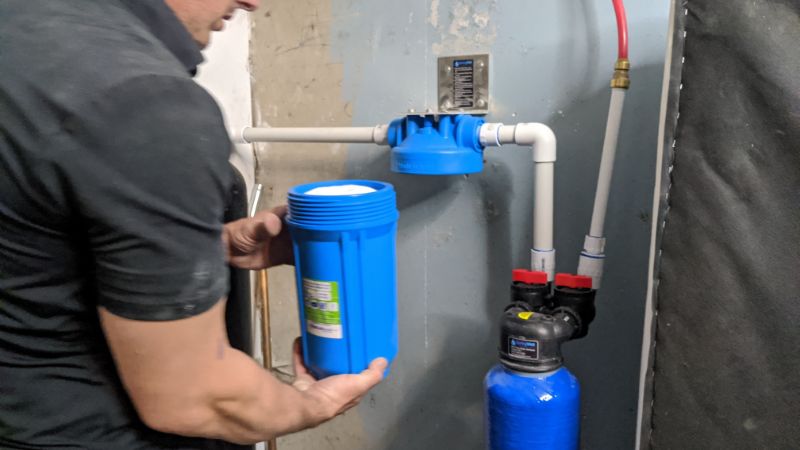
Spun-Cartridge Sediment Filter Cartridges (Depth Filters)
Spun-cartridge sediment filter types, otherwise known as depth filter cartridges, have a cylindrical shape and consist of layers of melted, spun polypropylene.
Water must pass through multiple filter media stages after entering depth filter cartridges, beginning with a porous, high-micron outer layer and passing through smaller and smaller media.
The gradually reducing micron size of the media in depth filters means that the largest particles are trapped first, and smaller particles are trapped in the increasingly smaller media layers.
Pleated Sediment Filter Cartridges (Surface Filters)
Pleated sediment cartridges, otherwise called surface filter cartridges, have pleated, folded filter media with a high micron rating.
Surface filters are designed for water that has a high content of large sediment particles.
Surface filter cartridges only target contaminants of a certain size, so they’re not intended for removing smaller contaminants from water. Pleated filters are more likely to be used as a pre-filter for whole house water filters.
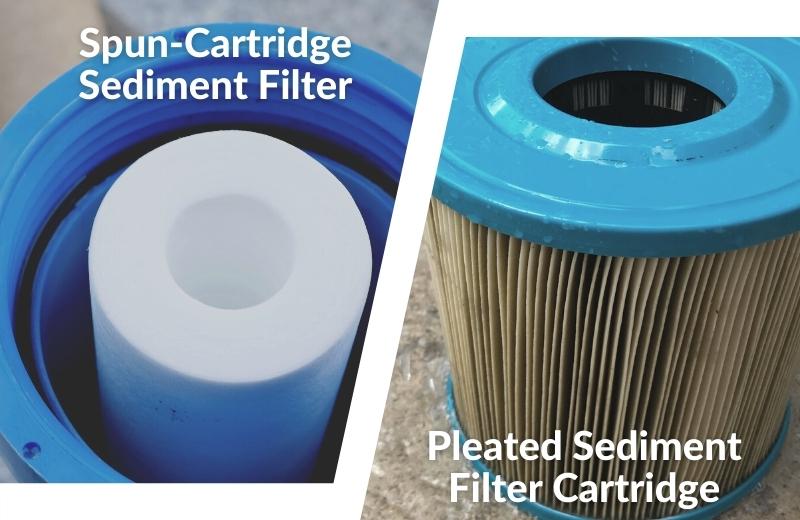
Continue Reading:
- What size micron filter for well water should I get?
- Check out the best sediment filters of 2025 right here
- The Best Whole House Water Filter Cartridges in 2025
▶️ Carbon Filter Cartridges
There are several carbon water filter cartridge options available today:
Granular Activated Carbon Cartridges
A granular activated carbon filter uses adsorption and chemical reactions to pull chemical contaminants, like chlorine, from water.
The large surface design of granular activated carbon filters allows them to trap more contaminants at once than carbon block filters (see below), preventing a drop in flow rate.
Carbon Block Filter Cartridges
Carbon block filters are made from a solid, compact block of carbon.
These filters are best for removing lead, chlorine, and sometimes microbiological contaminants, from water.
Catalytic Carbon Filter Cartridges
Catalytic carbon filtration is the best solution for water containing chloramine. Most other carbon filters can’t reduce this contaminant, because it’s harder to remove than chlorine.
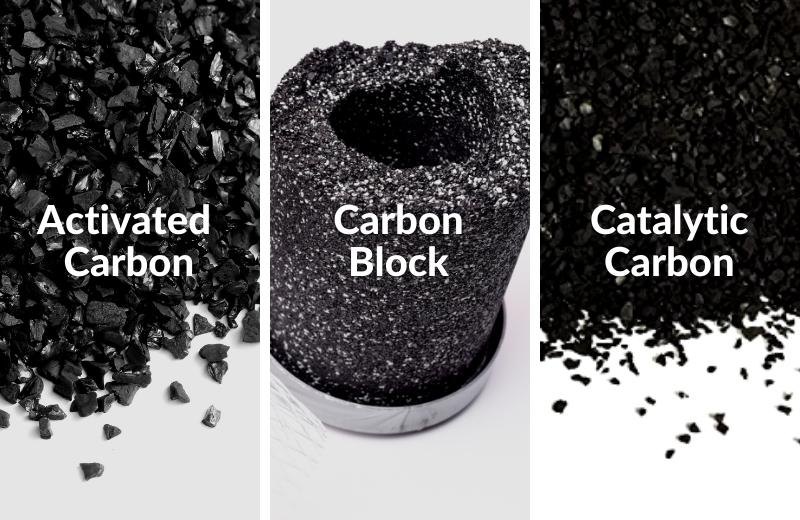
▶️ KDF Filter Cartridges
KDF filters are made from a copper-zinc blend and use a reaction known as redox to reduce contaminants like lead, chlorine, hydrogen sulfide gas, mercury, and chromium.
A KDF whole house water filter cartridge is often added to a carbon filter to improve the filter’s contaminant removal abilities.
▶️ Ion Exchange Filter Cartridges
An ion exchange water filter (not to be confused with an ion exchange water softener) is often included as an add-on to another filter, because it removes certain contaminants that most other filters can’t target.
Common contaminants removed by ion exchange filtration are sulfate, arsenic, and other negatively-charged inorganic substances.
▶️ Activated Alumina Filter Cartridges
An activated alumina water filter cartridge is treated with aluminum ore, which is highly adsorptive and porous. The filter is designed to remove contaminants by binding them to its media, preventing them from passing through with water.
Activated alumina cartridges are designed to target fluoride and arsenic, with up to 90% effectiveness for 12 months. AA filters can also remove thallium and uranium.
▶️ Ultrafiltration Cartridges
Ultrafiltration removes organic substances that are larger than 0.01 microns.
UF is similar to reverse osmosis, and is one of the few whole house water filter cartridges that can remove microorganisms like bacteria.
UF membranes also target salts, water hardness, pesticides, and herbicides.
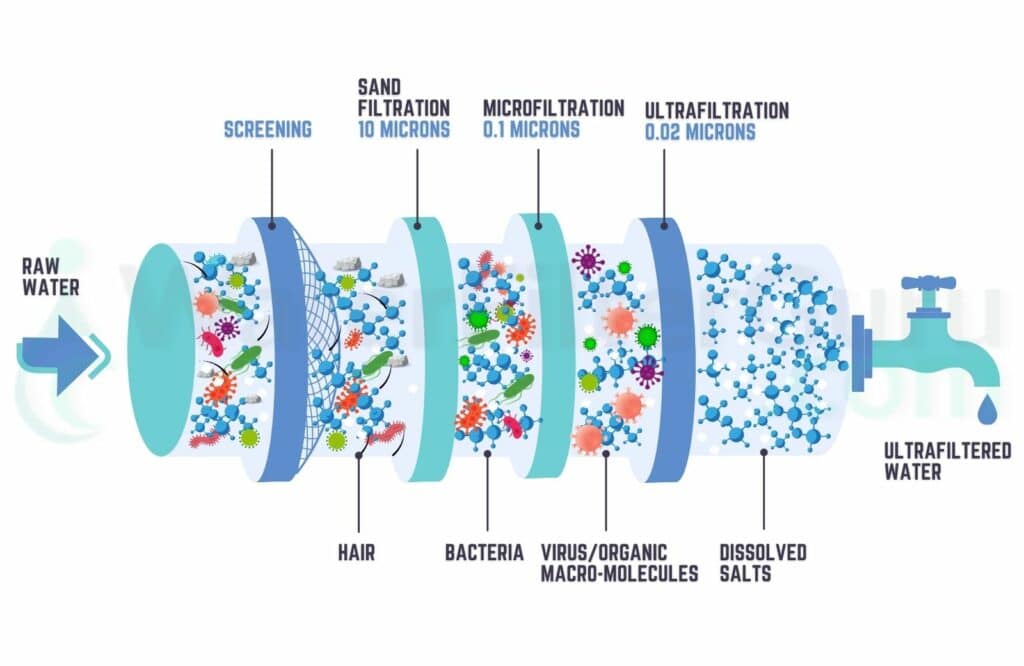
▶️ Reverse Osmosis Membranes
Reverse osmosis membranes, otherwise known as semi-permeable membranes, act as a physical barrier against contaminants as small as one-thousandth of a micron.
RO membranes remove virtually everything from water. They’re not technically a filter cartridge, but they perform a very similar role, preventing contaminants from passing through their tiny media.
Tannins, bacteria, heavy metals, chemicals, salts, and minerals are all removed from this type of whole house water filter.
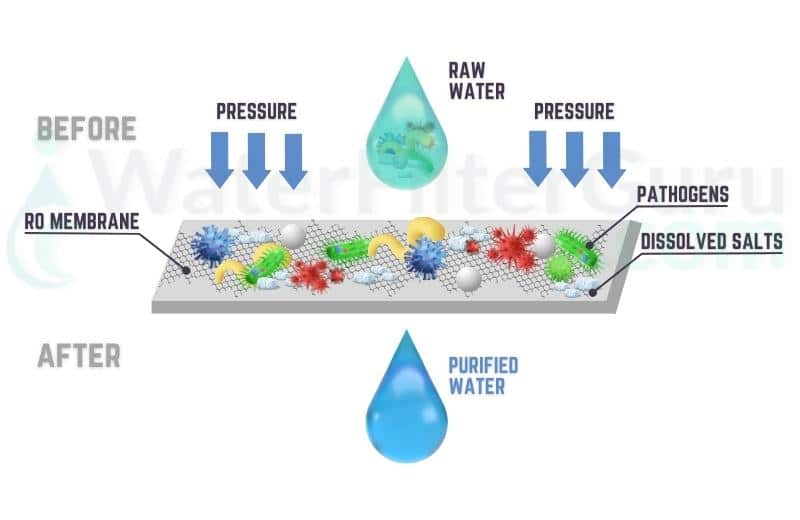
🤔 What is Filter Micron Rating and What Should You Choose?
Physical filter cartridges have a micron rating that tells you how effective the filters are at reducing contaminants down to a certain size.
For example, a 10-micron rating can remove contaminants down to 10 microns in size. All particulates that are smaller than 10 microns, including water particles, are able to pass through the filter’s pores. Any contaminants that are 10 microns or larger will be too big to fit through the pores, and they’ll become trapped in the media.
So, is there an “optimal” filter micron rating? Which should you choose?
Most water filters are sized between 0.5 and 50 microns, but there are filters with smaller and larger pores than this available to buy.
You should choose the right micron rating for the contaminants you want to remove. The higher the media’s micron rating, the bigger the contaminants that are targeted. So, if you have sediment-heavy water, look at sediment filtering cartridges that trap contaminants around 10-20 microns in size.
Most manufacturers of whole house water filter cartridges provide clear information about their filters’ micron sizes and the contaminants they can remove, so you don’t have to do the guesswork yourself.
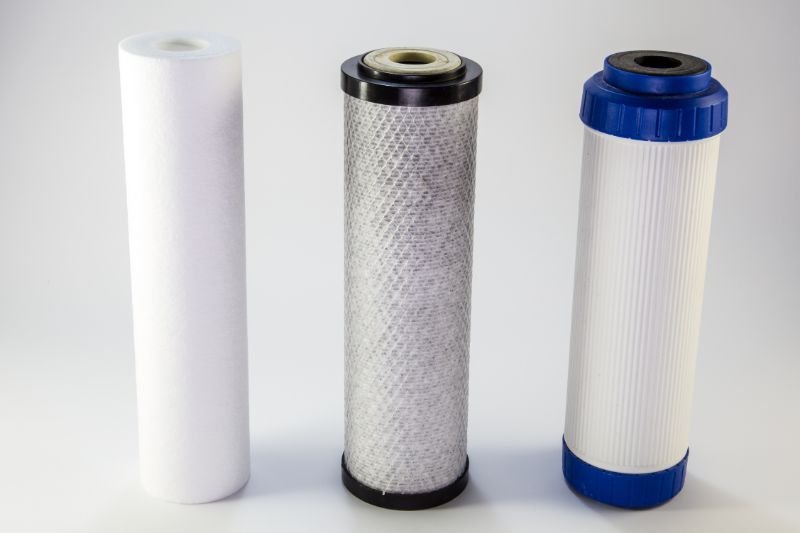
🚰 How Whole House Filter Cartridges Affect Flow Rate
The size of a whole house water filter cartridge, and the filtration process involved, affects the flow rate of water leaving the cartridge.
Larger filtering cartridges offer higher flow rates than smaller cartridges because they provide more space for a higher volume of water to pass through at once.
The micron size of the filter also affects flow rate. The smaller the filter microns, the smaller the contaminants that can pass through. The water flow will be slowed because there will be more resistance from the filter.
You’ll probably notice a small difference in your water flow after installing a whole house water filter system. But if your water pressure drops significantly, it’s a sign that the filter is too clogged with contaminants to perform properly, and you need to replace it.
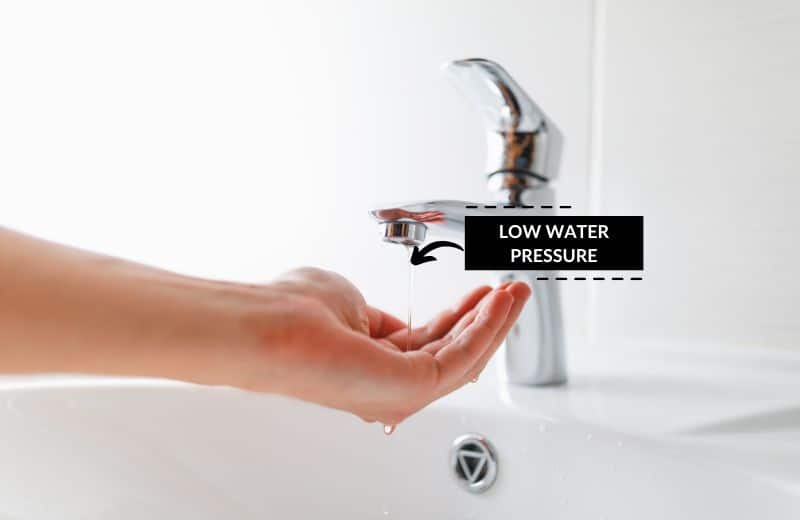
❇️ Non-Cartridge Filters
Most filter types are available in cartridge form. But there are some water treatment methods that are often labeled as “filters”, but they’re not available in cartridge form. Or, they’re available in cartridge form, but you can also buy them in other forms. These include:
- Carbon media: You can buy carbon media that sits inside a large tank, rather than being formed into a filter cartridge. When you need to replace the media (usually after around 5-10 years), you pour it out of the tank and pour new media in its place.
- KDF media: KDF media is the same – it can be worked into a filter cartridge or installed in a large tank.
- UV light: UV purification is often mislabeled as filtration, but there’s no way you’d find a filter cartridge offering the performance of a UV light. A UV system consists of a UV lamp in a sleeve. When water flows through the sleeve, the ultraviolet light kills microbes like bacteria and viruses.
- Water softening resin: Water softeners don’t filter water, and you can’t buy a filter cartridge with water softening benefits. Water flows through the tank containing resin, and the resin captures calcium and magnesium hardness minerals.
- Iron filters: Very few filtering cartridges can remove iron (apart from some sediment filters, which remove flecks of rust particles). Most iron filters use chemical or air injection and oxidation, requiring a tank with an air pocket and a birm or manganese greensand media bed. There’s no way for this complex process to be contained within a single filter cartridge.
- Spin-down sediment filters: Sediment cartridge filters are most commonly used in a whole house water filter system, but spin-down filters are popular as standalone filters for water with a high sediment content. These filters don’t have the traditional cartridge design – they look like large pipettes.
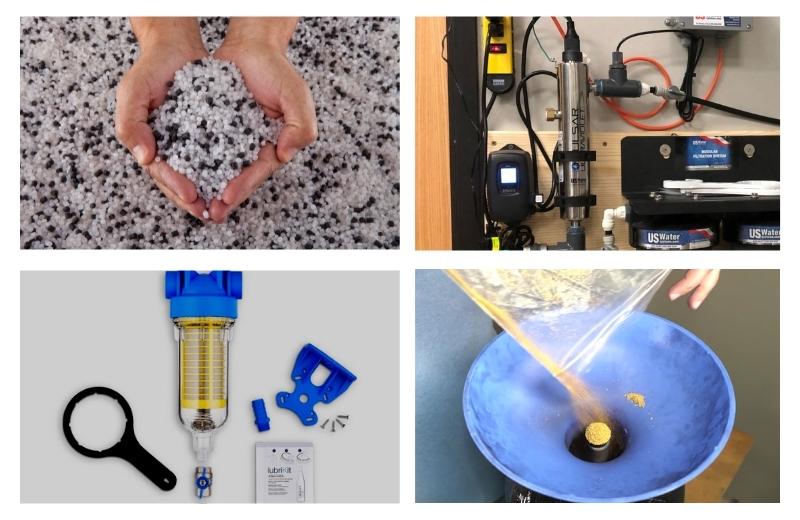
The purpose of this section is to show you that cartridge filters aren’t your only option for whole house filtration. If you’re dealing with iron, bacteria, or hardness minerals in your water, or you want a low-maintenance whole house filter that doesn’t need replacement cartridges, consider one of the filters mentioned in the list above.
Related Content:
🧠 Whole House Water Filter Cartridge Types: FAQs
Which is the best cartridge for water filter?
That depends on what you need to remove! The best cartridge for chlorine is an activated carbon filter, while the best cartridge for sediment is a (you guessed it) sediment filter, and the best cartridge for removing smaller particles like bacteria is an ultrafiltration filter.
Do your research and make a list of the contaminants found abundantly in your water source, then choose one or several different filter cartridges that can target these impurities.
Can I buy a different branded filter cartridge for my water filter?
It depends. If the cartridge is exactly the same size as the branded filter cartridge, and is designed to fit snugly in the housing in your water filtration system, you might get away with it. But generally, you’re only supposed to put the intended filters in the housing to prevent leaks and issues with blocking and decreased flow rate.
What size water filter cartridges are available?
You can buy water filters for whole house use in four different sizes:
- 2.5 x 10 inches
- 4.5 x 10 inches
- 2.5 x 20 inches
- 4.5 x 20 inches
These are the largest filter cartridge sizes available, and are designed to prevent a noticeable drop in water pressure. If you’re considering buying a filter that’s smaller than this size, don’t. Even if it’ll save you some money, it’ll have a major impact on your flow rate.
What are the 3 types of water filters?
There are more than three types of water filters, but the most common types of filters are mechanical cartridges, adsorption cartridges, and sequestration cartridges.
What is better 5 micron or 10 micron?
There’s no definite answer for this one – it depends on what you want to remove. A 5-micron cartridge removes a greater range of contaminants but will become clogged faster than a 10-micron filter.
What micron filter is best for well water?
Do you want to remove sediment, microbes, or something in between? The smaller the microns, the smaller the contaminants that can be removed. So, if you need to remove bacteria from your well water, choosing a 20-micron filter will be no good, because the bacteria will easily slip through the pores. It’s good to consider a combination of filters with different micron ratings to trap a selection of different-sized contaminants.
Which type of water filter is best for my home?
What do you want to remove? In terms of reliability, cartridge-based and tank-based systems are both good. Instead of choosing a specific type of filter based on what someone on the internet says is best, choose based on what your water contains, what has the best customer reviews, and what has the most evidence of good performance (such as third-party testing or certifications).


